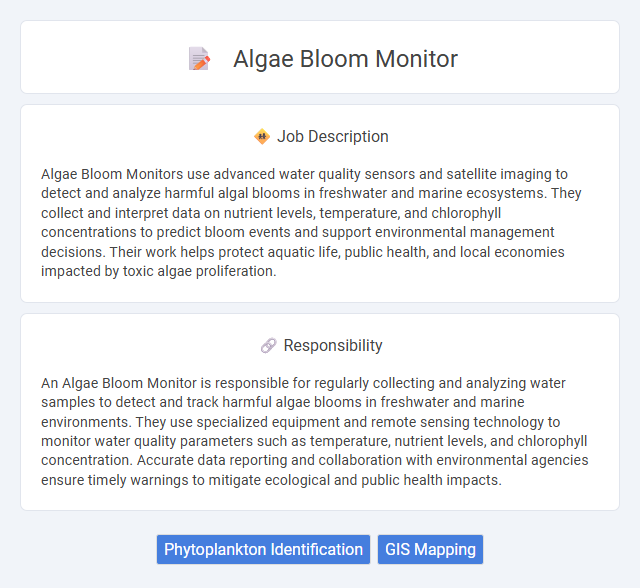
Algae Bloom Monitors use advanced water quality sensors and satellite imaging to detect and analyze harmful algal blooms in freshwater and marine ecosystems. They collect and interpret data on nutrient levels, temperature, and chlorophyll concentrations to predict bloom events and support environmental management decisions. Their work helps protect aquatic life, public health, and local economies impacted by toxic algae proliferation.
Individuals with a strong interest in environmental science and keen observation skills are likely suitable for an Algae Bloom Monitor role. Those comfortable with outdoor work and data collection in varying weather conditions may find this job fitting their preferences and abilities. Candidates prone to allergies or respiratory issues might face challenges due to potential exposure to algae and related toxins.
Qualification
Candidates for the Algae Bloom Monitor position must possess a strong background in environmental science, marine biology, or a related field, with expertise in water quality analysis and ecosystem monitoring. Proficiency in using remote sensing technologies and data interpretation software is essential for tracking and predicting algae bloom occurrences accurately. Experience in fieldwork, data collection, and familiarity with local aquatic ecosystems significantly enhance qualifying credentials for this role.
Responsibility
An Algae Bloom Monitor is responsible for regularly collecting and analyzing water samples to detect and track harmful algae blooms in freshwater and marine environments. They use specialized equipment and remote sensing technology to monitor water quality parameters such as temperature, nutrient levels, and chlorophyll concentration. Accurate data reporting and collaboration with environmental agencies ensure timely warnings to mitigate ecological and public health impacts.
Benefit
Algae bloom monitoring likely enhances environmental management by providing early detection of harmful algal blooms, which reduces risks to public health and aquatic ecosystems. The job may improve water quality by enabling timely interventions, potentially preventing fish kills and water contamination. It probably supports regulatory compliance and fishery sustainability efforts through precise data collection and analysis.
Challenge
Monitoring algae blooms likely presents challenges due to the unpredictable nature of environmental factors influencing their growth. Effective algae bloom monitoring may require advanced technology and real-time data analysis to accurately predict and track bloom occurrences. There is a probability that timely intervention depends on overcoming difficulties in both data collection and interpretation amid varying water conditions.
Career Advancement
Algae Bloom Monitor positions offer valuable experience in environmental science and water quality management, providing a strong foundation for career advancement in ecological research and public health sectors. Professionals in this role develop expertise in data collection, satellite imagery analysis, and remote sensing technologies, skills highly sought after in environmental consulting and governmental agencies. Progression opportunities include roles such as Environmental Analyst, Water Quality Specialist, or Conservation Scientist, often accompanied by increased responsibilities and leadership in monitoring programs.
Key Terms
Phytoplankton Identification
Algae bloom monitors specialize in phytoplankton identification to track and analyze harmful algal blooms (HABs) that impact aquatic ecosystems and water quality. Utilizing microscopy and molecular techniques such as DNA barcoding, they accurately classify phytoplankton species and assess bloom dynamics. Their data supports environmental monitoring, public health safety, and resource management by predicting bloom events and mitigating ecological damage.
GIS Mapping
Algae Bloom Monitor roles leverage GIS mapping technology to track and analyze the spatial distribution of harmful algal blooms across aquatic ecosystems. Using high-resolution satellite imagery and geospatial data layers, these professionals create detailed maps that identify bloom hotspots and predict their spread patterns. GIS-based monitoring aids in timely environmental management by providing actionable insights for water quality control and mitigation strategies.
 kuljobs.com
kuljobs.com